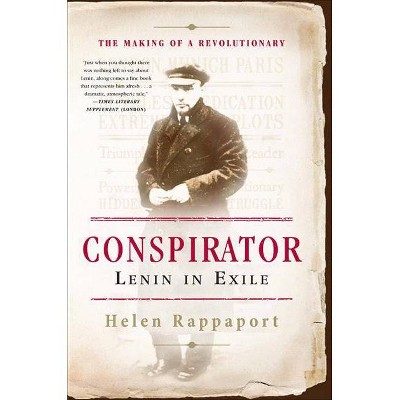Capturing the Light - by Roger Watson & Helen Rappaport (Paperback)

Similar Products
Products of same category from the store
AllProduct info
<p/><br></br><p><b> About the Book </b></p></br></br>"An intimate look at the journeys of two men--a gentleman scientist and a visionary artist--as they struggled to capture the world around them, and in the process invented modern photography. During the 1830s, in an atmosphere of intense scientific enquiry fostered by the industrial revolution, two quite different men--one in France, one in England--developed their own dramatically different photographic processes in total ignorance of each other's work. These two lone geniuses--Henry Fox Talbot in the seclusion of his English country estate at Lacock Abbey and Louis Daguerre in the heart of post-revolutionary Paris--through diligence, disappointment and sheer hard work overcame extraordinary odds to achieve the one thing man had for centuries been trying to do--to solve the ancient puzzle of how to capture the light and in so doing make nature 'paint its own portrait'. With the creation of their two radically different processes--the Daguerreotype and the Talbotype--these two giants of early photography changed the world and how we see it. Drawing on a wide range of original, contemporary sources and featuring plates in colour, sepia and black and white, many of them rare or previously unseen, Capturing the Light charts an extraordinary tale of genius, rivalry and human resourcefulness in the quest to produce the world's first photograph"--<p/><br></br><p><b> Book Synopsis </b></p></br></br><p><b>An intimate look at the journeys of two men--a gentleman scientist and a visionary artist--as they struggled to capture the world around them, and in the process invented modern photography <p/></b>During the 1830s, in an atmosphere of intense scientific enquiry fostered by the industrial revolution, two quite different men--one in France, one in England--developed their own dramatically different photographic processes in total ignorance of each other's work. These two lone geniuses--Henry Fox Talbot in the seclusion of his English country estate at Lacock Abbey and Louis Daguerre in the heart of post-revolutionary Paris--through diligence, disappointment and sheer hard work overcame extraordinary odds to achieve the one thing man had for centuries been trying to do--to solve the ancient puzzle of how to capture the light and in so doing make nature 'paint its own portrait'. With the creation of their two radically different processes--the Daguerreotype and the Talbotype--these two giants of early photography changed the world and how we see it. <br>Drawing on a wide range of original, contemporary sources and featuring plates in colour, sepia and black and white, many of them rare or previously unseen, <i>Capturing the Light</i> by Roger Watson and Helen Rappaport charts an extraordinary tale of genius, rivalry and human resourcefulness in the quest to produce the world's first photograph.</p><p/><br></br><p><b> Review Quotes </b></p></br></br><br><p>"A dual biography of Louis-Jacques-Mandé Daguerre and William Henry Fox Talbot, two men who separately announced inventions of photographic processes in France and England in 1839. The book is very readable, even exciting--good on the science and particularly good on the characters and social backgrounds of the two men. . . . Silver nitrate has been superseded by pixels for image making, but it was once the cutting edge, with all the excitement that goes with the miraculous." --<i>Wall Street Journal</i> <p/>"A well-timed and welcome history of the invention and spread of photography in the nineteenth century." --<i>Booklist</i> <p/>"An energetically written and deftly paced history of photography's origins, including the intricate rivalries surrounding Talbot and Daguerre's laborious attempts to permanently capture images seen through the camera obscura . . . gripping popular history." --<i>Publishers Weekly</i> <p/>"Rappaport offers an absorbing, perceptive, and detailed picture of a constitutional monarchy in crisis." --<i>Publishers Weekly on A Magnificent Obsession</i> <p/>"As shocking and immediate as a thriller. . . . [A] gripping read." --<i>People magazine, 3 1/2 stars on The Last Days of the Romanovs</i> <p/>"Quite simply, stunning. . . . Chilling and poignant, this is how history books should be written." --<i>Alison Weir, author of Henry VIII: The King and His Court on The Last Days of the Romanovs</i></p><br><p/><br></br><p><b> About the Author </b></p></br></br><p>ROGER WATSON is a world authority on the early history of photography. He is currently the Curator of the Fox Talbot Museum at Lacock Abbey and an occasional lecturer at DeMontfort University in Leicester. <p/>HELEN RAPPAPORT is a historian with a specialization in the nineteenth century. She is the <i>New York Times </i>bestselling author of <i>The Romanov Sisters</i>, as well as eight other published books, including <i>The Last Days of the Romanovs</i> and <i>A</i> <i>Magnificent Obsession: Victoria, Albert and the Death that Changed the Monarchy</i>.</p>
Price History
Cheapest price in the interval: 20.49 on October 22, 2021
Most expensive price in the interval: 20.49 on November 8, 2021
Price Archive shows prices from various stores, lets you see history and find the cheapest. There is no actual sale on the website. For all support, inquiry and suggestion messagescommunication@pricearchive.us




















